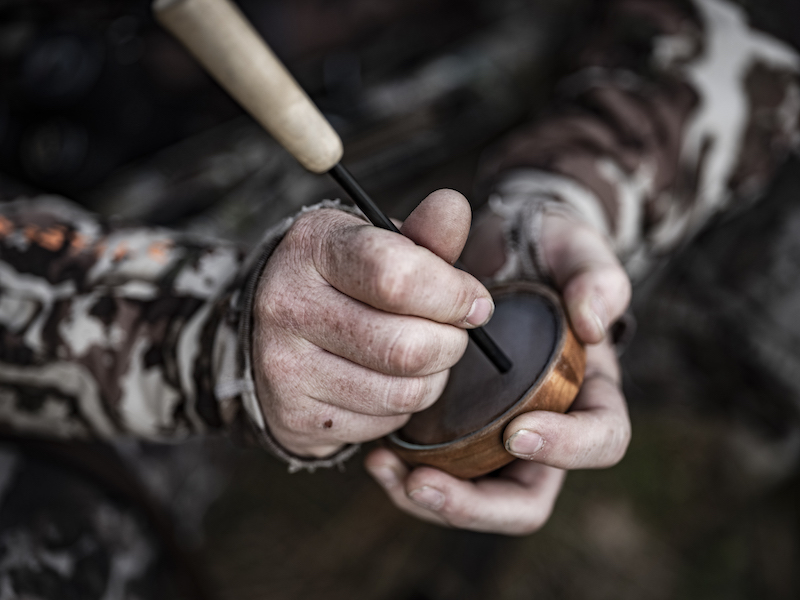Spring is upon us and you’re prepped for your first turkey hunt. You have your gear, your license and a good place to hunt, but what’s your game plan? Andy Gagliano, an avid turkey hunter and host of “The Turkey Hunter Podcast,” checks in to game-plan a day in the turkey woods. Use his schedule to plan a full day of turkey-hunting fun.
Before Dawn: Rise and shine! Set your alarm so you have time to eat breakfast, pack a lunch, and drive to your hunting site. To save time, pack your gear and vehicle the night before. Gagliano arrives in the woods at first light to listen for toms gobbling on the roost. If you located a roost earlier, get between the roosted bird and where it often feeds or picks up hens.

Be prepared for an ethical shot the second you get settled in your spot. Photo Credit: National Wildlife Federation
At Sunrise: Wait quietly and patiently. “I like to let Mother Nature do her thing,” Gagliano said. “I choose not to make a sound, and let a turkey gobble on its own.” If you hear a gobble, Gagliano suggests getting close while it’s dark. Whether you’re already set up or you’re in the process of setting up, getting close boosts your odds. If the bird flies down nearby, you’ll be set up to make an ethical shot. If you don’t hear a gobble 30 or 40 minutes after daylight, use your owl call to prompt a “shock gobble.”
Midmorning: If nothing happens but there’s a bird nearby, Gagliano stays put. “If a tom has hens with him and he’s not receptive, I’ll let him take care of business,” Gagliano said. “Once the hens leave, I’ll try to strike him up with aggressive hen calling.” After a hen is bred, she’ll usually leave the tom at midmorning to nest. That’s when Gagliano uses calls he’s practiced to entice a tom his way. Aggressive yelps and clucks can excite a tom looking to breed again. If you don’t find a bird by midmorning, move elsewhere and try calling. Learn how to call here.

Call to attract the turkeys, but don’t over-call. Photo credit: John Hafner
Late Morning: If you locate a bird midmorning but it doesn’t respond to your calls, Gagliano recommends sneaking out to pursue other options. If you find a different bird, great! Game on! If not, circle back to your starting point to reconnect with the morning’s first gobbler. Courting an unreceptive bird is better than not courting anything.
But if you didn’t find a tom all morning, stay mobile, keep exploring and keep calling, but not too much. “I don’t want turkeys to know I’m in the woods, so I try to stay quiet,” Gagliano said. “I think most people like to hear themselves call, so they’ll call a lot. That’s a hindrance. If other hunters have pressured the turkeys you’re hunting, they probably won’t respond to your calls.”
Lunch Break: As the day warms, Gagliano heads to shaded areas – such as a ridgeline – to eat lunch and call blindly. Turkeys have dark feathers, so they seldom stand in fields when it’s hotter than 80 degrees and the sun is blazing. Your best chance is to wait in the shadows and hope a gobbler wanders by looking for other birds.
Early Afternoon: With warm temps and a full stomach, Gagliano rests and recuperates. “After lunch most days, my eyelids get heavy,” he said. “I might take a nap when I’m sitting against a tree.” Gagliano said he’s a light sleeper, so gobblers have awakened him at midday. When they gobble randomly, they’re often lonely, which creates great calling opportunities.

Decoys may serve you well this time of day. Photo Credit: ATA
Midafternoon: Still nothing? Gagliano starts hunting fields. “Turkeys don’t spend an entire day in one area,” he said. “[A tom] could go to a ridge between where he roosted and a field where he struts. If he doesn’t find success, maybe he’ll go to a field and spend a few hours there.” Gagliano sets up decoys in fields because they’re potential strut zones and feeding areas. Decoys help lure toms within shooting distance. If the property you hunt doesn’t have fields, hardwood bottoms are also midafternoon hotspots.
Early Evening: If you’ve made it this long and have 40 minutes of daylight left, Gagliano suggests packing up and searching for roost trees. Turkeys sleep in trees to avoid predators like bobcats and coyotes. Look for mature timber with open understories, which give birds ample space to fly up in the evening and down at dawn. If you locate roosted birds – or ones about to roost – wait until after dark to leave. Waiting ensures you don’t spook the bird. Then you’ll know where to set up before dawn the next morning, and you can start your day over.

Don’t let yourself feel defeated. One unsuccessful day does not make an unsuccessful season. Photo Credit: John Hafner
“Don’t go eat breakfast or go fishing just because you don’t kill a turkey right off the branch,” Gagliano said. “I hunt until I’m successful, or until I legally can’t hunt anymore that day. Hunters who consistently have more success are the ones who spend the most time in the woods. You can’t kill a bird if you aren’t there. Plus, you never know when a turkey hunt will turn around and go your way.”
Turkey hunting is unpredictable. You can kill a turkey at any time in daylight, so give yourself as many chances as possible to harvest a gobbler. All you need is patience and persistence.
For more turkey-hunting tips, read these Bowhunters United articles:
Then, visit an archery shop for turkey-hunting gear and more!